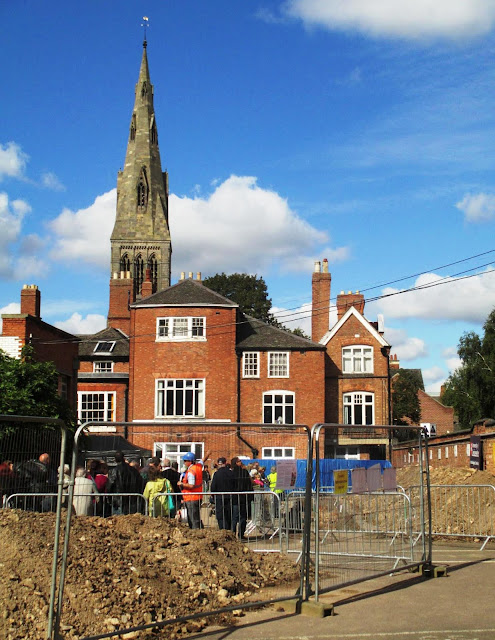 |
| The Greyfriars site yesterday, with Leicester Cathedral in the background |
Stopping only to make an observation I have already made here about the irony of Richard's remains being found in the car park of Leicester's social services department, Maev Kennedy talks to some of the archaeologists involved in the dig at Greyfriars:
Getting permission to excavate after years of research by local historians and the Richard III Society, was surprisingly easy, said Professor Lin Foxhall, one of the archaeologists from Leicester University who led the team, "because nobody expected us to find anything".
"I didn't expect us to find anything," said Foxhall. "It is incredibly rare in archaeology to go looking for a named individual. Even the fact that the trenches were sunk in exactly the right place, so that we immediately located a church which has been buried for 500 years – if we'd found nothing else – was extraordinary.
"Then to find bones, exactly where the records say Richard was buried — well, I am still completely astonished by the whole thing."
Jo Appleby was the bones expert who, dressed from head to foot in white plastic, like a character from CSI, to prevent contamination, excavated the skeleton. "I thought at best we'd get a jumble of different bones, some of which might be from approximately the right period. I still can't quite believe it. When I saw the gash in the skull, and the twisted spine, the hair stood up on the back of my neck."
Foxhall and Appleby point out that they have nothing but circumstantial evidence – but say it is "very, very strong circumstantial evidence".
"We have a grown man, buried in a position of great honour near the altar in the church but without much in the way of ceremony, with a twisted spine and a terrible battle injury – he didn't get that walking home drunk from the pub," says Appleby.
There was no evidence of a coffin, or of the body having been clothed, but the bones were quite undisturbed so Appleby believes he was buried in a shroud. The hole was slightly too short for the body, and she also found some broken medieval floor tiles, as if the grave was dug hastily by smashing a hole through the floor.I am pleased to say that Kennedy (her article is on the Guardian website) does not give any space to the idea that Richard should be reburied in London or York:
Since 1980 the cathedral has had what looks just like a grave: a large, handsomely inscribed slab in front of the high altar. Every 22 August it is wreathed in flowers, on the anniversary of the Battle of Bosworth, when the last Plantagenet lost his horse in marshy ground, and then his life and his crown, which legend says rolled from his dying head under a furze bush.
Candles lit by a stream of visitors burn perpetually nearby, and many people have left white roses since news of the bones' discovery went round the world.
The cathedral authorities say that if the identity is confirmed, they will work with the royal household, and the Richard III Society, to ensure "the remains are treated with dignity and respect and are reburied with the appropriate rites and ceremonies of the church".
So the King's wish to be buried in York is to be ignored.
ReplyDeleteWill he never get any consideration or dignity.